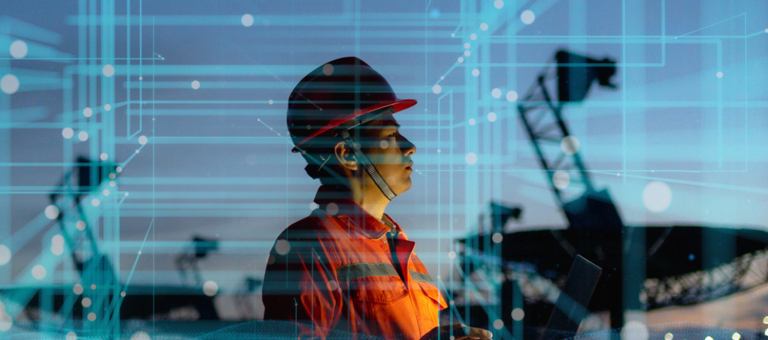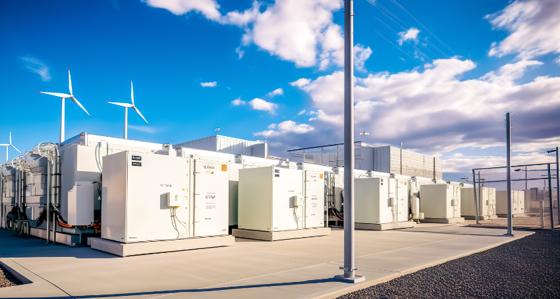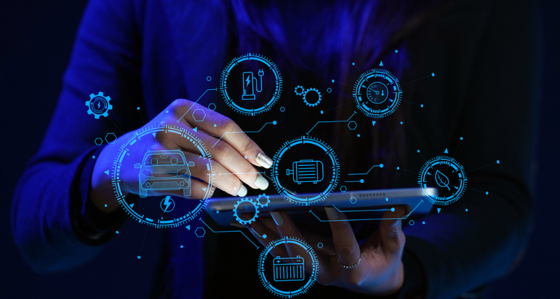
Unlocking value through digital twins and IoT: A blueprint for intelligent asset management
7 min read 19 June 2025
Digital twins are transforming maintenance strategies by enabling predictive, data-driven decision-making. These dynamic virtual replicas of physical assets continuously ingest real-time IoT data from embedded sensors, allowing for precise monitoring of asset conditions and the early detection of potential failures. This proactive approach not only prevents unexpected breakdowns but also extends asset lifespans and reduces lifecycle costs.
A key advantage of digital twins is the shift from traditional time-based maintenance to condition-based maintenance (CBM). Instead of relying on fixed schedules, maintenance activities are automatically triggered based on actual asset performance and health indicators derived from IoT telemetry. This ensures optimal resource allocation, minimises unnecessary interventions, and significantly reduces downtime.
The integration of IoT and interoperability frameworks is essential to unlocking the full potential of digital twins. IoT devices provide the continuous, high-fidelity data required to maintain an accurate and responsive digital model. Meanwhile, interoperability—achieved through standardised APIs, middleware, and seamless integration with enterprise systems (eg Enterprise Resources Planning (ERP), Computerised Maintenance Management System, Supervisory Control and Data Acquisition)—ensures that digital twins can operate within a broader digital ecosystem. This enables real-time synchronisation across departments, from operations to supply chain and finance.
By leveraging this interconnected infrastructure, digital twins enhance decision-making and operational efficiency. Predictive analytics applied to IoT data enables early fault detection, root cause analysis, and optimised maintenance planning. This approach is not only more effective but also more cost-efficient than reactive maintenance, which often involves increased labour, unscheduled supply chain requests, and downtime costs.
In addition, through this interconnected infrastructure, digital twins improve the RAMS profile—Reliability, Availability, Maintainability, and Safety of critical infrastructure. Continuous performance monitoring and trend analysis help identify degradation patterns, enabling timely interventions that reduce unplanned outages and enhance operational resilience.
Why interoperability coupled with integration is the key to success for IT / OT convergence and delivering a working digital twin?
Digital twins are required to integrate seamlessly with existing systems through various technological approaches. These virtual replicas of physical assets require real-time data from multiple sources, such as sensors, IoT devices, and existing IT systems such as ERP systems and similar enterprise systems.
ERP systems like SAP, Oracle and others similar system serve as the central nervous system of many organisations. Digital twins must communicate with these systems to process relevant data and provide real-time updates. This integration ensures that all operational data is synchronised across the enterprise and accessible for decision-making.
Digital twins create a comprehensive digital image of warehouse and transport logistics by integrating deeply with Warehouse Management Systems (WMS) and Transport Management Systems (TMS) enhancing logistics. This allows for real-time optimisation of stocks and inventory management, picking processes, and supply chains.
Lately the cloud platforms have started to play a significant role in the integration of digital twins. Cloud-based solutions offer flexible storage and computing capacities, enabling digital twins to scale efficiently. Hybrid approaches can be used to store particularly sensitive data in local data centres while leveraging the cloud options (private and public) for other operations.
The synergy between IoT and digital twins facilitates better decision-making and operational efficiency
The Internet of Things (IoT)/Industrial Internet of Things plays a crucial role in the integration and interoperability. IoT devices, equipped with sensors and connectivity, continuously collect and transmit data from physical assets to their digital counterparts. This real-time data is essential for creating accurate and dynamic digital twins that mirror the current state of physical assets. The data collected by IoT devices allows digital twins to simulate real-world conditions, predict potential failures, and optimise maintenance schedules. This integration helps in reducing downtime and improving the overall efficiency of asset management.
By leveraging IoT data, digital twins provide insights into key aspects contributing to the organisational KPI’s like
- System performance, potential issues, and maintenance needs
- Real-time analysis supports informed decision-making and enhances the reliability and performance of assets
The combination of these technologies allows for the creation of customised solutions and services, driving innovation in the energy and notably in the asset intensive industries across board. This integration not only improves operational efficiency but also opens new avenues for innovation and development.
Defining data and its integration pathways to digital twins
It is an established fact that data at the right quality, frequency and accuracy are vital for any real time operations. Automated data integration with IoT devices is essential for accurate simulations and optimisations. The continuous acquisition and transmission of real-time data from IoT devices and sensors are critical for maintaining the precision of digital twins.
Standardised APIs facilitate seamless communication between digital twins and existing systems and unlocking the value of the underlying data. An open architecture ensures that digital twins can integrate with various company systems without creating isolated solutions. This standardisation enables smooth data exchange and interoperability.
This integration supports with the right interventions around standards and architecture enhances the overall efficiency of asset management.
In conclusion, a successful IT / OT convergence will enable digital twins to redefine the future of asset management. By enabling predictive maintenance, automating workflows, and integrating with enterprise systems, they provide a comprehensive, data-driven approach to managing complex physical infrastructure. The result is not only improved reliability, availability, and safety but also measurable cost reductions and operational efficiencies.
As organisations increasingly adopt digital twin technologies, the ability to integrate across platforms—ERP, Work Management Systems, Terminal Management Systems, and cloud—becomes the key aspect of scalable, intelligent asset strategies. The synergy between digital twins and IoT unlocks insights, agility, and innovation, positioning businesses to thrive in a data-centric, performance-driven world.
To fully realise this potential, companies must invest in robust data architectures, embrace open standards, and prioritise interoperability. We’ve seen our clients gaining a decisive edge in optimising asset performance, reducing lifecycle costs, and driving sustainable value across their operations. Get in touch with Tandon Oberoi and Silas O’Dea to find out more.
Our Experts



Related Insights

From Pilots to Portfolios: Scaling the Rollout of Utility Microgrids
Across the U.S., utilities are under pressure to deliver reliable, affordable energy in the face of rising risks and shifting policies. Download our research to see how scaling microgrids can help meet that challenge.
Read more
Unlocking the North Sea’s future potential with digital and AI
The North Sea is ready for its next chapter - powered by AI and digital innovation. Discover how this energy giant can be transformed into a low-carbon leader while boosting efficiency, investment, and resilience.
Read more
Safeguarding critical energy infrastructure against converging cyber and physical threats
UK energy utilities strengthen their resilience against emerging cyber-physical threats by developing a holistic security methodology that bridges digital and physical domains.
Read more
Vom Commodity-Anbieter zum intelligenten Dienstleister: Wie Energieversorger mit KI den Kundenservice transformieren
Die Rolle von Künstlicher Intelligenz im Wandel der Energiebranche
Read moreIs digital and AI delivering what your business needs?
Digital and AI can solve your toughest challenges and elevate your business performance. But success isn’t always straightforward. Where can you unlock opportunity? And what does it take to set the foundation for lasting success?